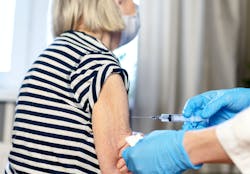RSV vaccines would greatly reduce illness if implemented like flu shots
Respiratory syncytial virus (RSV) vaccines recently approved for people 60 and older would dramatically reduce the disease’s significant burden of illness and death in the United States if they were widely adopted like annual influenza vaccines, a new study has found.
A high level of RSV vaccination would not only potentially reduce millions of dollars in annual outpatient and hospitalization costs but would also produce an economy of scale with individual shots being delivered at a relatively modest cost of between $117 and $245 per dose, the study said.
The vaccines are currently covered by most private insurers without a patient copay because they are recommended by the Centers for Disease Control and Prevention’s Advisory Committee on Immunization Practices. Some Medicare beneficiaries can also obtain the shots at no cost, but only if they are enrolled in Part D of the program, which deals with drug benefits.
The current study looked only at the potential impact and cost of RSV vaccines for older adults.
Two RSV vaccines, Arexy and Abrysvo, were approved by the U.S. Food and Drug Administration earlier this year.
In conducting their study, the researchers created a model for RSV outcomes based on characteristics of the U.S. population 60 or older. Measured outcomes included the annual incidence of cases per 100,000 people requiring outpatient, inpatient, and intensive care, and the death rate for hospitalized patients. The researchers then calculated the medical care costs for these outcomes and lost productivity.
The researchers analyzed how these outcomes would be reduced if 66% of adults 60 and older received an RSV vaccine. That is the typical influenza vaccination coverage for adults 65 years or older in the U.S.
For comparison, the researchers also analyzed the impact of 100% RSV vaccination coverage. In each scenario, they factored in the efficacy of the vaccine at preventing the need for medical care and death. They looked at the impact of these levels of RSV vaccination over one year and then over two years.
They found that 66% vaccination coverage in the first year reduced outpatient care by 41.4% to 53.6%, hospitalizations by 57.6% to 60.5%, and RSV-related deaths by 58.5% to 60.4%.
Increasing vaccination coverage to 100% reduced outpatient care by 62.9% to 81.2%, hospitalizations by 87.4% to 91.7%, and deaths by 87.6% to 91.3%.
Based on these numbers, the maximum cost-effective price per dose for one season at 66% coverage was $118 to $127. The difference was small — $1 to $3 — for 100% coverage.
With the annual cost savings achieved from vaccination, a program where 66% of adults 60 and older are vaccinated for RSV would cost the U.S. health care system $6.4 to $7.1 billion for one season, and $9.7 to $10.7 billion at 100% vaccination, the researchers found.
The vaccines are intended to protect people over two RSV seasons, as clinical trials for the vaccine showed efficacy for that time. But the researchers felt that until real-world efficacy data are available, a one-season analysis was more appropriate.
If real-world data show strong efficacy over two seasons, Arexvy could be cost effective up to $235 per dose and Abrysvo up to $245 per dose, the researchers found.

